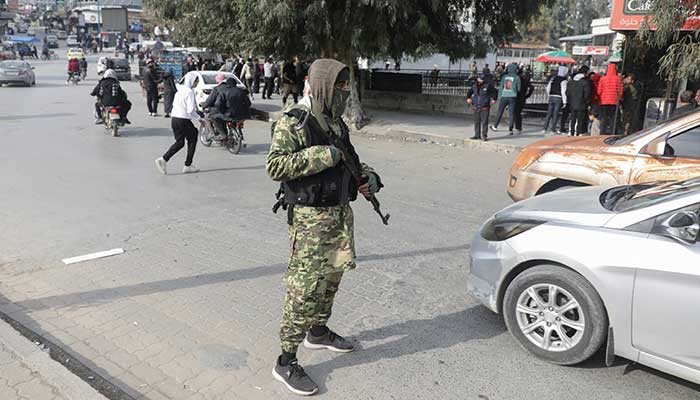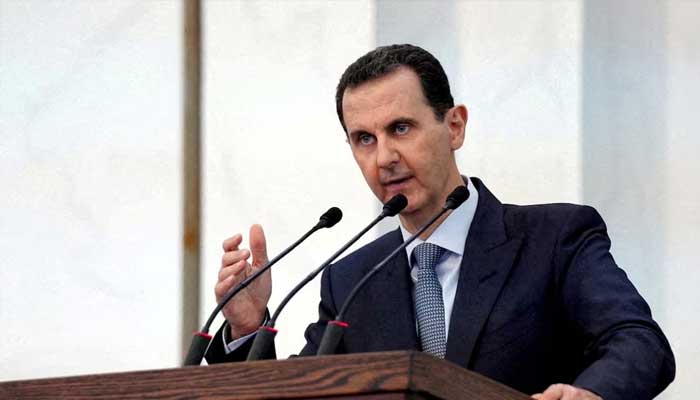BEIRUT: As the commander of al Qaeda’s franchise in the Syrian civil war, Abu Mohammed al-Golani was a shadowy figure who kept out of the public eye, even when his group became the most powerful faction fighting President Bashar al-Assad.
Today, he is the most recognisable of Syria’s triumphant insurgents, having gradually stepped into the limelight since severing ties to al Qaeda in 2016, rebranding his group and emerging as the de facto ruler of rebel-held northwestern Syria.
The transformation has been showcased since rebels led by Golani’s Hayat Tahrir al-Sham (HTS), formerly known as the Nusra Front, swept through the nation and declared they had ousted Assad on Sunday after seizing the capital Damascus.
Golani has featured prominently in the takeover, sending messages aimed at reassuring Syrian minorities who have long feared the rebels.
“The future is ours,” he said in a statement read on Syria’s state TV, urging his fighters not to harm those who drop arms.
When rebels entered Aleppo, pre-war Syria’s largest city, at the start of their sweep to Damascus, a video showed Golani in military fatigues issuing orders by phone, reminding fighters to protect the people and forbidding them from entering homes.

He visited Aleppo’s citadel accompanied by a fighter waving a Syrian revolution flag: once shunned by Nusra as a symbol of apostasy but recently embraced by Golani in a nod to Syria’s more mainstream opposition.
“Golani has been smarter than Assad. He’s retooled, he’s refashioned, made new allies, and come out with his charm offensive” towards minorities, said Joshua Landis, a Syria expert and head of the Center for Middle East Studies at the University of Oklahoma.
PR effort?
Aron Lund, a fellow at think-tank Century International, said Golani and HTS had clearly changed though still remaining “pretty hardline”.
“It’s PR, but the fact they are engaging in this effort at all shows they are no longer as rigid as they once were. Old-school al Qaeda or the ISIS would never have done that,” he said.
Golani and the Nusra Front emerged as the most powerful of the multitude of rebel factions that sprang up in the early days of the insurgency against Assad over a decade ago.
Before founding the Nusra Front, Golani had fought for al Qaeda in Iraq, where he spent five years in a US prison. He returned to Syria once the uprising began, sent by the leader of the IS group in Iraq at the time — Abu Omar al-Baghdadi — to build up al Qaeda’s presence.
The US designated Golani a terrorist in 2013, saying that al Qaeda in Iraq had tasked him with overthrowing Assad’s rule and establishing Islamic sharia law in Syria, and that Nusra had carried out suicide attacks that killed civilians and espoused a violent sectarian vision.
Turkey, the Syrian opposition’s main foreign backer, has designated HTS a terrorist group, while supporting some of the other factions that fight in the northwest.
Golani gave his first media interview in 2013, his face wrapped in a dark scarf and showing only his back to the camera. Speaking to Al Jazeera, he called for Syria to be run according to sharia law.
Some eight years later, he sat down for an interview with the US Public Broadcasting Service’s FRONTLINE programme, facing the camera and wearing a shirt and jacket.
Golani said the terrorist designation was unfair and that he opposed the killing of innocent people.
He detailed how the Nusra Front had expanded from the six men who accompanied him from Iraq to 5,000 within a year.
But he said that his group had never presented a threat to the West. “I repeat — our involvement with al Qaeda has ended, and even when we were with al Qaeda we were against carrying out operations outside of Syria, and it’s completely against our policy to carry out external action.”
Messages to minorities
Golani fought a bloody war against his old ally Baghdadi after IS sought to unilaterally subsume the Nusra Front in 2013. Despite its al Qaeda ties, Nusra was regarded as more tolerant and less heavy-handed in dealings with civilians and other rebel groups compared to IS.
The group was subsequently beaten out of territory it held in both Syria and Iraq by an array of adversaries including a US-led military alliance.
As IS was collapsing, Golani was cementing the grip of HTS in the northwestern Syrian province of Idlib, establishing a civil administration called the Salvation Government.
Assad’s government viewed HTS as terrorists, along with the rest of the rebels.

The HTS administration has issued statements seeking to assure the Shi’ite Alawites and other Syrian minorities. One statement urged the Alawites to be a part of a future Syria that “does not recognise sectarianism”.
In a message to residents of a Christian town south of Aleppo, Golani said they would be protected and their property safeguarded, urging them to remain in their homes and to reject the Syrian government’s “psychological warfare”.
“He’s really important. The main rebel leader in Syria,” said Lund.
He said HTS had displayed “logistical and governance capacity” by ruling its own territory in Idlib for years.
“They have adopted the symbols of the wider Syrian uprising… which they now use and try to claim the revolutionary legacy — that ‘we are part of the movement of 2011, the people who rose up against Assad’.”


